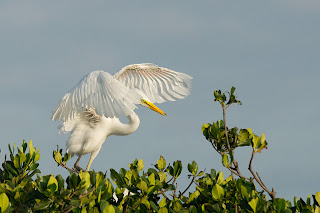Mercury poisoning from agriculture has been a scourge in the Everglades for decades. Fish eat the mercury, birds eat the fish. The more favorable the hydrology is for concentrated prey, the greater the mercury exposure to the birds. I ran across a study that measured mercury levels in nesting great egrets and white ibises in 2006 (excellent breeding conditions) and 2007 (below average breeding conditions). I was expecting to get very depressed while reading the report. Given that great egrets are "upper level trophic piscivores" (not only that, they are fish eating animals high on the food chain), their exposure to mercury during excellent breeding conditions would naturally be high.
The report found high mercury levels in these birds, especially during excellent breeding season. The great egret experiences the brunt of it, while the "lower trophic level generalist" white ibis does not consume much mercury. However, in the great egret chick, most of the mercury gets routed into the growing wings. This might be because feathers represent the majority of growth in the nestling. Once fully grown, feathers lose their blood vessels and so whatever mercury is in the feathers will stay in the feathers. Because of this, the chicks are buffered from the poison. In fact, bird feathers are used as indicators of heavy metal pollution. So the good news from the report is that the mercury does not have a negative impact on these birds, at least in the short term.
At the rookery this past weekend, I watched several great egret and brown pelican chicks exercise their not-yet-fully-grown wings. Upon examining the photos, you can surmise that stages of growth that occurs. The feathers, which are nothing more than extensions of the skin are comprised of remiges and coverts. Remiges are the large flight feathers that we love to photograph so much. These are often referred to as primaries (the outer wings) and secondaries (inner wings). The coverts are smaller, closer to the bird's torso and form an outer layer of insulation. When you look at the nestlings wings, you can see that the coverts are not formed yet, leaving the remiges exposed. The underside of the great egret wings look more like skin than feather.
The first two photos below are egret nestlings. The first was shot this past weekend and clearly shows the lack of covert feathers on the bird. The second photo was shot approximately 1 year ago. You can see that this bird's feathers are more developed and appear more adult-like. The third photo shows an adult.
Not to forget the brown pelican, the nestlings are also working hard to spread their wings. The first photo shows a juvenile that is close to fledging. The second photo includes two juveniles at different stages; one not yet able to leave the nest and the about-to-fledge juvenile. Notice the adult hunkered in its nest. The third photo again demonstrates a young nestling exercising its small wings. Compared to the first photo, this baby has a ways to go!









No comments:
Post a Comment